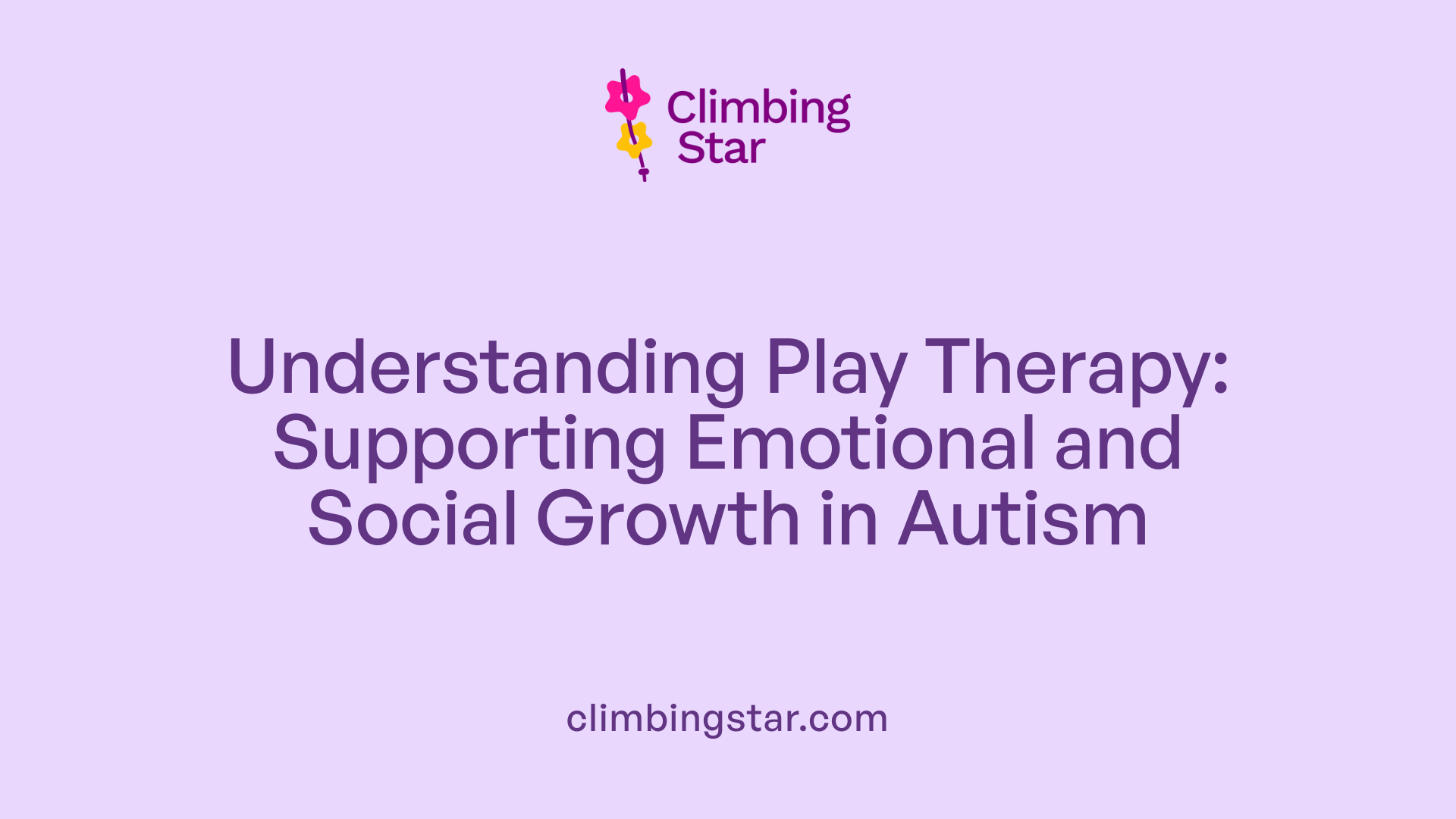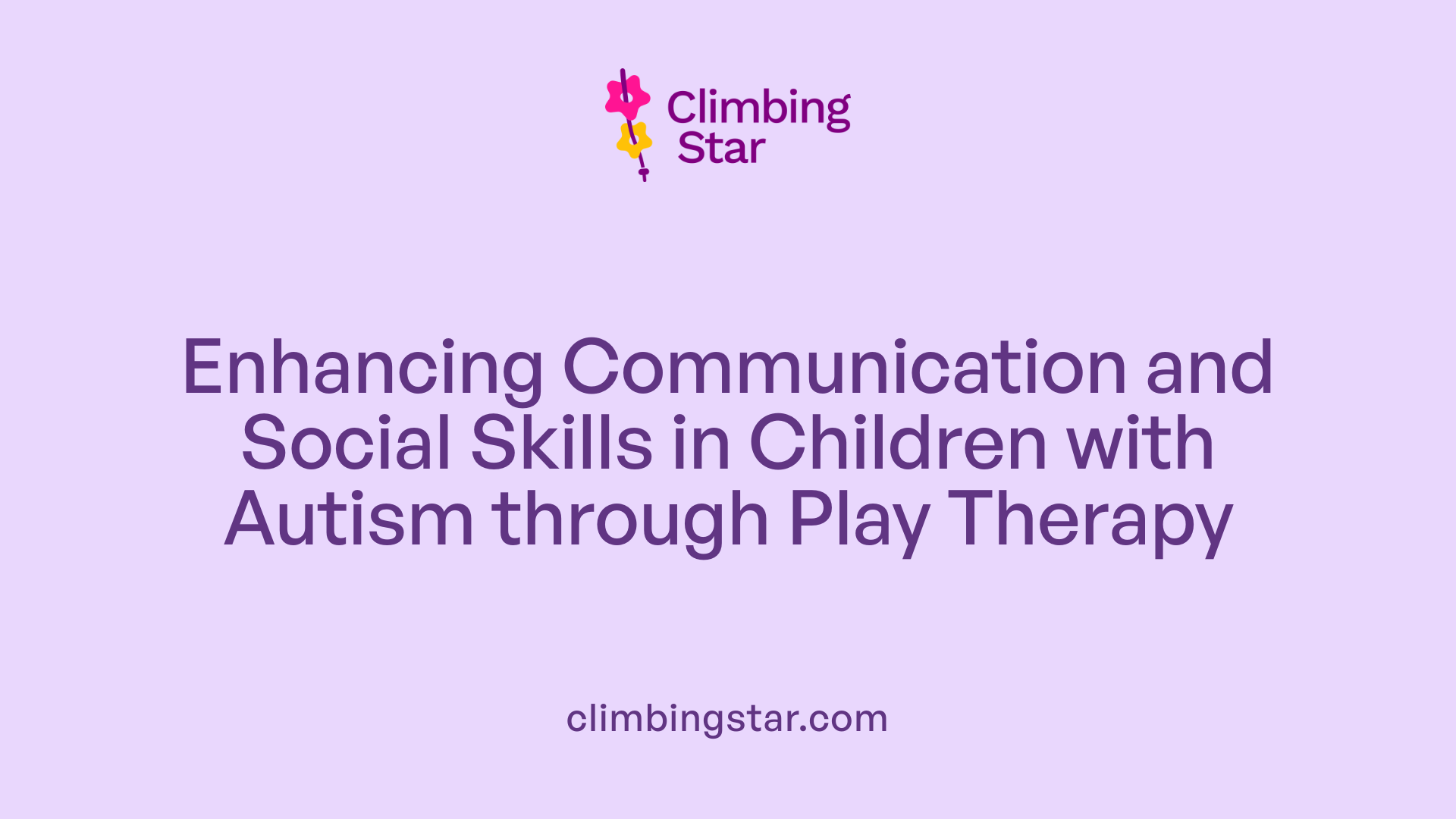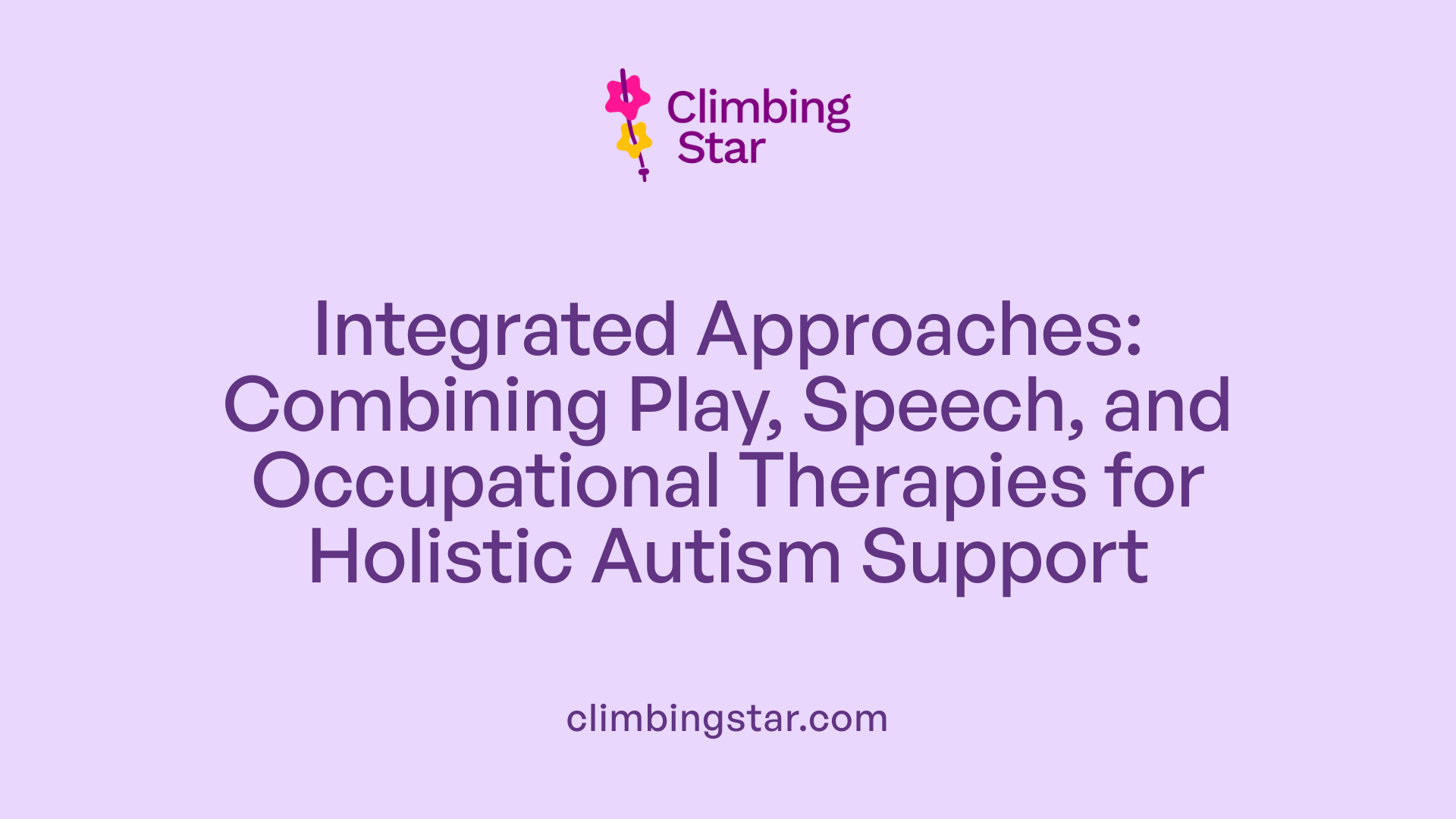Understanding Play Therapy in the Context of Autism
Play therapy is a powerful, structured approach designed to help children with autism spectrum disorder (ASD) express emotions, develop social skills, and resolve psychosocial difficulties through play. Unlike other therapies that may rely heavily on verbal communication or structured drills, play therapy capitalizes on children's natural mode of communication—play—to foster growth in multiple developmental areas. This article explores what play therapy is, how it supports children with autism, its various methods, and the importance of integrating it within a comprehensive treatment plan alongside approaches like Applied Behavior Analysis (ABA).
Defining Play Therapy and Its Role in Autism Support

What is play therapy?
Play therapy is a structured, theoretically based approach where trained therapists use play activities to help children express feelings, communicate experiences, and resolve psychosocial challenges. According to the American Play Therapy Association, it systematically applies a theoretical model to support children in preventing or overcoming various social and emotional issues.
Purpose and goals
Play therapy leverages children’s natural learning process through play to improve communication skills, emotional regulation, behavior modification, and social interactions. For children with autism, it helps express thoughts and feelings in a comfortable way. It also fosters cognitive development, problem-solving abilities, and builds self-esteem.
Age range applicability
While traditionally used for children aged 3 to 12, play therapy is increasingly adapted for teenagers and adults. Its flexible nature allows it to address developmental needs across a wide age range, making it a versatile therapeutic tool.
Therapist qualifications
Qualified play therapists are licensed mental health professionals who receive advanced training specific to play therapy. Many earn credentials such as Registered Play Therapist (RPT), ensuring they are equipped with specialized knowledge to work effectively with children, including those with autism.
How Play Therapy Addresses Communication and Social Challenges in Autism

How does play therapy support communication and social interaction in children with autism?
Play therapy harnesses the natural language of children—play—to support both verbal and nonverbal communication development in children with autism. By engaging children in meaningful play activities, therapists provide a comfortable, expressive outlet where children can share their thoughts and feelings, even if they struggle with conventional speech.
One significant benefit of play therapy is encouraging social interaction. Techniques like role-playing and turn-taking simulate everyday social situations, helping children practice essential social behaviors in a supportive environment. These activities foster cooperation, patience, and empathy, which are often challenging for children with autism.
Furthermore, play therapy supports emotional regulation by allowing children to recognize and manage their feelings through creative and structured play. This process helps children develop coping strategies and reduces frustration or anxiety during social interactions.
In summary, play therapy creates a safe space where children with autism can improve communication skills, build social connections, and gain emotional control through interactive and purposeful play.
Diverse Play Therapy Techniques Tailored for Autism

What Are the Different Play Therapy Techniques Used for Children with Autism?
Play therapy encompasses a variety of techniques that are adapted to meet the unique needs of children with autism. Each method leverages play to support emotional, social, and cognitive development.
Child-Centered Play Therapy (CCPT)
This approach allows children to lead the play session, expressing themselves freely with minimal therapist direction. It empowers children to communicate their feelings and thoughts through their natural play instincts, fostering self-expression and emotional regulation.
Floortime (DIR Model)
Floortime encourages therapist and child interaction at the child's developmental level, using play to build relationships and enhance social, emotional, and communication skills. It targets core autism challenges by promoting engagement and emotional connection through interactive play.
Sensory Play
Sensory play incorporates activities that stimulate the child's senses, such as touch, sound, and movement. This is particularly helpful for children with autism who often experience sensory processing differences, aiding in self-regulation and improving attention.
Social Stories and Role-Playing
These techniques involve scripted narratives and interactive scenarios to teach social cues, communication, and appropriate behaviors. By rehearsing social situations, children can practice and learn essential life skills in a safe and structured environment.
Equine-Assisted Play Therapy
A more innovative approach, this therapy involves interaction with horses to promote emotional growth and social skills. It combines physical activity with play, providing sensory input and opportunities for building confidence.
These diverse techniques highlight the flexibility of play therapy to address multiple facets of autism, from communication difficulties to emotional challenges. Each method can be tailored to the individual child's strengths and needs, frequently integrating with other therapeutic modalities for comprehensive care.
Integrating Play Therapy with Other Autism Treatments

How does play therapy combine with speech therapy, occupational therapy, and cognitive behavioral therapy?
Play therapy is frequently integrated with other therapeutic interventions to maximize benefits for children with autism. Speech therapy complements play therapy by enhancing communication skills during interactive play. Occupational therapy, especially when combined with sensory integration techniques, supports the child's fine and gross motor skills as well as emotional regulation. Cognitive Behavioral Therapy (CBT) is used alongside play therapy to address challenging behaviors and foster problem-solving abilities in structured scenarios.
What role does sensory integration play in this integrated approach?
Sensory integration is a crucial component often embedded within occupational therapy and play therapy treatments. It helps children with autism process sensory information effectively, improving their emotional well-being and daily functional capabilities. Incorporating sensory play activities within therapy sessions enhances engagement, aids in emotional regulation, and promotes typical developmental progress.
Why is an interdisciplinary approach important in autism treatment?
An interdisciplinary treatment model brings together specialists from different fields—such as play therapists, speech-language pathologists, occupational therapists, and psychologists—to create a comprehensive and individualized care plan. This teamwork ensures that all developmental areas, including communication, social skills, emotional health, and cognitive function, are addressed holistically.
How are parents involved in this integrated therapy model?
Parental involvement is essential for reinforcing the skills learned during therapy sessions. Parents are often included in play therapy sessions or training to understand techniques, thus ensuring consistency and practice at home. This collaborative approach boosts the effectiveness of treatment by creating a supportive environment and strengthening the child’s progress over time.
Benefits and Outcomes of Play Therapy for Children with Autism

How Does Play Therapy Improve Social Skills, Communication, and Emotional Regulation in Children with Autism?
Play therapy uses the natural language of children—play—to enhance important skills in children with autism. Through engaging activities such as role-playing, turn-taking, and creative expression, children develop better social interaction abilities. Play therapy supports both verbal and non-verbal communication by providing comfortable ways for children to express their thoughts and feelings. It also aids emotional regulation by helping children recognize and manage their emotions within a safe and structured environment.
What Role Does Play Therapy Have in Neuroplasticity and Brain Development?
Play therapy affects all areas of the brain and promotes neural development, particularly during childhood when brain plasticity is highest. By participating in diverse play activities, children with autism can enhance neural connectivity and cognitive functions. This stimulation supports adaptive behavior and overall developmental progress, potentially inducing beneficial neuroplastic changes that improve brain function.
How Does Play Therapy Help Reduce Problematic Behaviors?
Using play to express difficult emotions and experiences helps children redirect unwanted behaviors toward more appropriate forms. Play therapy provides toys and activities that are of interest to the child, which encourages positive engagement and reduces behavioral challenges. This therapeutic approach is considered safe and cost-effective, making it a valuable tool for managing behavioral issues associated with autism.
In What Ways Does Play Therapy Build Confidence and Self-Esteem?
Successfully engaging in play activities promotes a sense of accomplishment and mastery. This builds a child’s confidence and self-esteem, encouraging further social participation and emotional growth. The inclusive nature of play therapy ensures every child, regardless of their abilities, can experience success and personal development.
| Benefit | Description | Impact on Children with Autism |
|---|---|---|
| Social Skills Development | Role-playing and turn-taking foster social interactions | Improves peer relationships and cooperation |
| Communication Enhancement | Support for verbal and non-verbal expression | Helps express thoughts and feelings authentically |
| Emotional Regulation | Recognizing and managing emotions through creative play | Reduces anxiety and emotional outbursts |
| Neuroplasticity and Brain Growth | Stimulates neural networks enhancing adaptive behaviors | Enhances cognitive and functional development |
| Reduction in Problematic Behaviors | Redirects negative behaviors toward positive activities | Decreases tantrums and aggression |
| Confidence and Self-Esteem | Successful play engagement builds self-worth | Encourages participation and social engagement |
Applied Behavior Analysis (ABA) Therapy: A Complementary Approach
What is Applied Behavior Analysis (ABA) therapy and how does it support individuals with autism?
Applied Behavior Analysis (ABA) therapy is a science-based approach that focuses on understanding and changing behavior through the use of learning principles such as positive reinforcement. This therapy helps individuals with autism develop essential skills in communication, social interaction, and daily living. It not only promotes positive behaviors but also works to reduce challenging behaviors, supporting overall development and adaptation.
Who provides ABA therapy and what qualifications do these professionals hold?
Professionals who provide ABA therapy include Board Certified Behavior Analysts (BCBAs) and Registered Behavior Technicians (RBTs). These practitioners undergo advanced education and certification processes to ensure they deliver evidence-based, effective treatment plans tailored to each individual's needs. Their expertise guarantees adherence to high standards in behavioral intervention.
What are the common techniques and methods used in ABA therapy?
ABA therapy employs a variety of techniques including:
- Positive reinforcement: rewarding desired behaviors to encourage their recurrence.
- Prompting: guiding the individual toward correct responses.
- Behavior chaining: breaking down complex activities into manageable steps.
- Discrete trial training: structured teaching sessions focusing on specific skills.
- Pivotal response treatment: targeting key behavior areas to produce widespread improvements. Visual supports and individualized data-driven plans are also integral, ensuring progress is measurable and personalized.
This comprehensive approach makes ABA a valuable complement to therapies like play therapy, enriching the support available for individuals with autism.
Effectiveness and Considerations in Choosing ABA and Play Therapy Providers
What Research Supports ABA and Play Therapy for Autism?
Both Applied Behavior Analysis (ABA) and play therapy have strong research backing their effectiveness for children with autism. ABA therapy is shown to significantly improve communication, social skills, and adaptive behaviors, particularly when started early and delivered intensively with data-driven, individualized programs. Play therapy complements this by enhancing emotional regulation, social interaction, and problem-solving skills through natural play processes. Studies indicate play therapy also encourages neuroplastic changes, builds confidence, and reduces problematic behaviors.
What Factors Influence Success in Therapy?
The success of both ABA and play therapy largely depends on individualized approaches tailored to the child's unique needs. Duration and intensity—such as approximately 20 play therapy sessions lasting 30 to 50 minutes each—vary per individual. Family involvement is critical, reinforcing skills learned during therapy. Combining therapies, such as play therapy with speech or occupational therapy, often yields better outcomes. Ethical, data-driven frameworks and continuous progress monitoring are also essential components.
How to Select Qualified Therapy Providers?
Families should seek licensed mental health professionals with advanced training for play therapy, often holding credentials like Registered Play Therapist (RPT). ABA providers should follow evidence-based practices with a strong ethical foundation and transparent communication about costs and methodologies. Providers who engage families as active participants and incorporate multidisciplinary approaches are preferable.
Why Are Individualized, Ethical, and Family-Involved Approaches Important?
Every child with autism responds differently to therapies; thus, proper evaluation and customizing therapy plans are necessary for effective intervention. Ethical frameworks ensure treatments respect the child's dignity and well-being. Active family participation helps generalize skills outside therapy sessions and supports consistent progress. Integrated strategies foster comprehensive development, addressing behavioral, emotional, and cognitive needs.
| Therapy Aspect | ABA Therapy | Play Therapy |
|---|---|---|
| Evidence Base | Extensive research for early, intensive intervention | Supported by studies, especially for emotional and social skills |
| Provider Qualifications | Board Certified Behavior Analysts preferred | Licensed therapists with RPT or equivalent credentials |
| Treatment Focus | Communication, behavior modification, adaptive skills | Emotional expression, social skills, cognitive development |
| Family Role | Active involvement and training | Parent participation in sessions and reinforcement |
| Delivery Format | Structured, data-driven sessions | Flexible, child-centered play sessions |
These considerations help families make informed choices to optimize development and well-being for children with autism.
Innovations and Future Directions in Play Therapy for Autism
What are some emerging methods in play therapy for autism?
Innovative play therapy methods such as art-play therapy, tele-play therapy, and equine-assisted therapy are gaining attention for their potential to support children with autism. Art-play therapy combines creative art activities with traditional play techniques, allowing children to express emotions and thoughts visually and symbolically. Tele-play therapy leverages technology to provide remote play therapy sessions, increasing accessibility especially during times when in-person visits are challenging. Equine-assisted therapy involves interactions with horses, promoting emotional regulation, social skills, and confidence.
How is play therapy customized to individual needs?
Customization is crucial in play therapy because every child with autism has unique challenges and responses to therapy. Through thorough evaluations, therapists select and adapt approaches based on individual interests, sensory sensitivities, and developmental goals. Techniques can be combined or adjusted—for instance, incorporating sensory integration strategies within child-centered play or using role-playing aligned with a child's preferred activities. This personalized approach maximizes therapeutic benefits and engagement.
What are the potential neuroplastic benefits of play therapy?
Play therapy may induce neuroplastic changes by enhancing neural networks that support cognitive and social functions. Engagement in varied play activities stimulates different brain areas responsible for communication, emotional regulation, and problem-solving. These experiences promote neural connectivity and brain development, especially critical during childhood when brain plasticity is highest. Consequently, play therapy not only addresses behavioral symptoms but might also support foundational brain growth and adaptability in children with autism.
What about cost-effectiveness and safety?
Play therapy is considered a safe intervention with minimal risks, making it suitable for children across a broad spectrum of issues. It is also regarded as cost-effective, particularly because it can be integrated with other therapies such as speech or occupational therapy, providing a comprehensive and efficient treatment approach. Its flexibility in delivery—such as in-person or tele-play sessions—adds to accessibility and potential treatment adherence. Overall, these factors support the continued exploration and application of play therapy in autism care.
The Promise of Play Therapy in Autism Treatment
Play therapy stands as a vital, adaptable intervention that leverages children's innate mode of expression—play—to address the unique challenges faced by those with autism. Complemented by other evidence-based therapies like ABA, play therapy enriches communication, socialization, emotional regulation, and cognitive development while fostering confidence and self-esteem. Its various tailored methods and integration within multidisciplinary treatment plans make it a compelling option for families seeking holistic support. Continued innovation and research promise to expand its efficacy and accessibility, reinforcing play therapy's essential role in nurturing the potential of every child on the autism spectrum.
References
- Play Therapy Makes a Difference
- The Role of Play Therapy in Autism Treatment
- Play therapy in children with autism: Its role, implications ...
- Applied Behavior Analysis (ABA)
- ABA Techniques: Strategies for Behavior Analysts - GSEP Blog
- ABA Therapy Examples, Definition & Techniques
- Applied Behavior Analysis (ABA)
- Applied Behavior Analysis (ABA)
- Applied Behavior Analysis (ABA)
- Applied Behavior Analysis (ABA)







